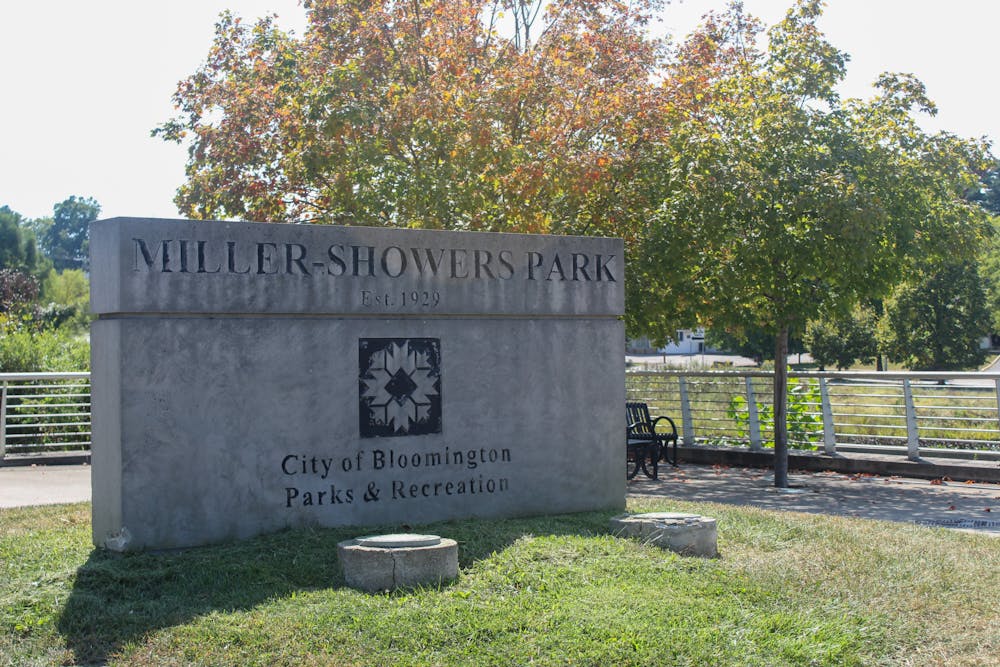Following public pressure, Bloomington plans to reschedule site improvements for the construction of the Bicentennial Gateway Project in Miller-Showers Park to the spring of 2024, according to an Oct. 27 press release. Described as a monolith by some members of the public, the structure has drawn fierce criticism from a group of citizens.
Prior to the city’s most recent announcement, the project had been stalled by the Bloomington Board of Public Works. On Oct. 10, the board was unsuccessful in voting for the closure of a lane and sidewalk in order to begin erecting the structure. Though the monolith has been approved by the Bloomington City Council since 2018, delays from the board have left the current state of the project unclear.
In their press release, the city said the decision to postpone construction was made to allow city staff to consider feedback from the public, design team and other city departments, boards and commissions.
The monolith is a 40-foot structure built out of aluminum, featuring the word “Bloomington” from top to bottom, according to the city. The monolith will include glowing internal LED lights that are customizable. While the monolith is the main part of the project, its construction will also include improving the area surrounding it by redoing the crosswalk, renovating the curb and planting trees.
The project is expected to cost $1.1 million and has been sourced out to contractors, according to the city. The city awarded a $575,000 contract to Reed and Sons Construction for the site improvement, a $395,105 contract to bo-mar Industries for the fabrication of the structure and a $133,925 contract to architects at Rundell Ernstberger Associates for the research and design.
According to the city, the monolith project is one of the projects funded by bicentennial bonds, which are non-mandatory investments that fund public works. In 2018, the City of Bloomington began selling bicentennial bonds, which have funded tree planting, bike lanes, trails and other improvements to public works in Bloomington. The funding has come from bonds purchased by Bloomington residents, not from taxes collected by the government.
Only recently has the project received backlash, seemingly due to the lack of communication between the city’s parks and recreation department and the general public when it was first proposed. While acknowledging some people had complaints, Tim Street, director of the Bloomington Parks and Recreation Department, said that communication was a priority.
“Public engagement is important obviously, and we try to take steps with every project to make sure that the public is engaged,” Street said.
The opponents of the monolith have banded together with a Facebook group sarcastically titled “All Hail the Monolith.” The page serves as a public forum for those in opposition of the project. It gives them spaces to share satirical memes about the structure’s physical appearance and discuss ways to fight its construction. The group shares many concerns for the project.
Allen Rose, an administrator of the Facebook group, organized a protest in an effort to oppose the structure. He also created the Public Art Citizens Committee, a group of people who feel dissatisfied with the lack of local art use in recent Bloomington projects.
“Just a few weeks ago, when we saw the design of it and especially the way it was depicted with the Milky Way behind it, it was so fake and it was so ugly and so boring and so stupid,” Rose said.
Denise Valkyrie has been a Bloomington resident for over 20 years and has worked on other projects in the Bloomington economic and arts developmental area. She expressed her concern for the structure not representing the true nature of Bloomington.
“Bloomington isn’t known for flashy Vegas lights, you know?” Valkyrie said. “We’re more known for being a community that appreciates nature, appreciates education and celebrates the stone workers that have come before us. I don’t see how this monolith, this gateway, reflects that.”
Another concern of the group is the project will not feature local artists and local materials. The contractors for the project’s construction and appearance, Rundell Ernstberger Associates and bo-mar Industries, are both based in Indianapolis.
Other concerns include the light pollution it may produce, which the city’s parks and recreation department has claimed will not be an issue. They have answered this question on the official City of Bloomington website, claiming that because the lights are internal and do not point towards the sky, light pollution will not be a problem.
The frustration from the public stems from a wider issue of what some residents see as a lack of transparency and public awareness from city government when it comes to making decisions that affect citizens.
“It's kind of emblematic of dissatisfaction that a lot of locals are having with the way things are going with local government,” Rose said. “So in a way it's more than just about this particular art project, but a kind of lack of transparency and engagement with the public, leaving people out of the process or just missing their concerns."
Although some believe the project should be made obsolete, both Rose and Valkyrie were against scrapping the project as a whole. Redesigns that more properly represent Bloomington’s culture and feature local artists are just a few ideas for reworking the project.
The Facebook group is in the process of collecting signatures for a petition against the monolith and is continuing to lobby against it in future board meetings.




